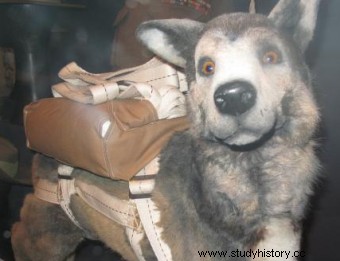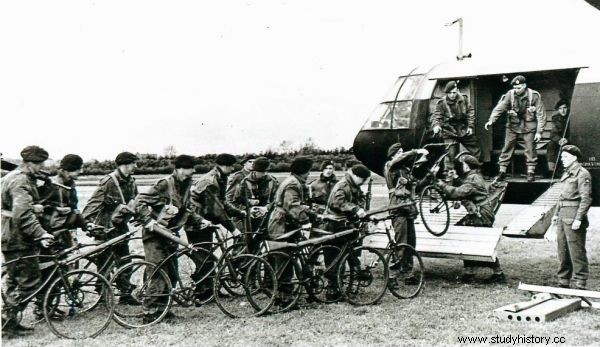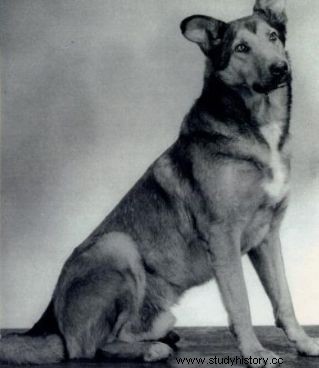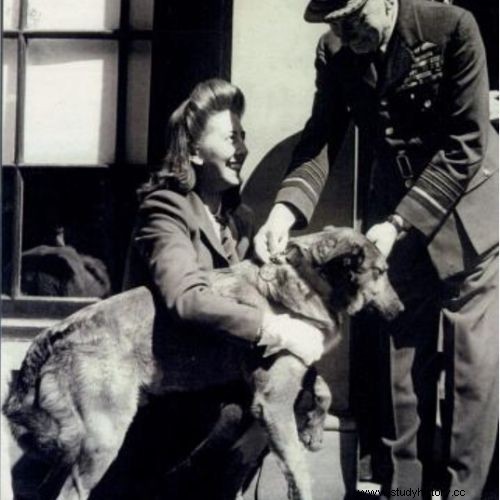What do you need to teach your dog to parachute? First of all:a soulless six-year-old girl who will give her pet to the army for "safekeeping". Second:a vet who tells you you need meat stuffed in pockets to encourage your dog to jump out of the plane. Third:a military shoe as an emergency incentive.
In plainclothes, his name was Brian, while in service he was called Bing. He was half a Scottish Shepherd, half German. He joined the army as a result of the courageous experiment of the 13th Lancashire Parachute Battalion, which was preparing for D-Day.
The military decided to include dogs in their ranks. The so-called "Paradogs" were specially trained as amphibious dogs. They were supposed to parachute under enemy fire together with people. In addition, they acted as mascots, raising the morale of soldiers fighting in enemy territory.
Hard training not for cowards
Service dogs were obtained through an official radio appeal to British citizens. The first such appeal was broadcast in 1941, and many people considered the army an ideal place to "store" their pets during the difficult period of the war. They didn't seem to be worried about their dogs ending up in the Hell of War, not a shelter.

Fortunately, it's not a stuffed Bing, but his museum image. At least we think so.
Thus, two-year-old Brian, given by six-year-old Betty Fetch, ended up in the 13th Battalion. He was recruited into the British Army as War Dog No. 2720/671 in 1944.
Fearful quadrupeds had no chance for a military career, because the training began with getting used to noise, behavior under fire, learning to recognize the smells of explosives and gunpowder, as well as reacting to the capture of the guardian by the enemy. After two months the jumps started. The slender bodies of the dogs turned out to be an asset, as the army could use parachutes designed to transport ... bicycles.

Dropping dogs down with a parachute is not much different from transporting bicycles. At least that's what the British army thought.
You don't want to jump? It's from the shoe!
Andrew Woolhouse in his book about the 13th Parachute Battalion states that dogs began to be trained at the beginning of 1944 due to the veterinary training of the Kpr battalion. Ken Bailey. In his notebook he described the first training jump made with Ranee - his German Shepherd bitch. She was the only "paratrooper" in the battalion. Everything went smoothly, Ranee was able to withstand the jump very well, she had no problems either leaving the plane or landing.
The rule was that the dogs were not given food or drink before jumping, and the soldiers kept portions of meat with them so that the dogs would jump out after them, and also to feed their dogs after landing, thus rewarding them for jumping and making them in the habit of looking for them. on the battlefield. If any of them had problems with motivation, they didn't get too much attention. The military boot saved the situation and the dog immediately regained his courage. Even the heroic Bing needed such help at least once in his career.
Noses and ears on the battlefield
Dogs proved to be very useful in battle. Locating mines and traps flawlessly. One of the surviving soldiers of the 13th Battalion recalled that if they detected anything, they would sit next to the suspicious place and gaze at the guardian with eyes full of satisfaction and expectation. In addition, they helped during patrols by pointing out enemy positions and thus saved the lives of many Allied soldiers.

Bing puffs his chest proudly.
Many four-legged heroes gave their lives in battle. Monty was seriously injured on D-Day, Ranee was separated from her battalion after landing, and her hearing was lost. Their places were taken by two other German Shepherds who quickly became friends with Bing. Bing himself also suffered many wounds but that did not prevent him from continuing his active duty.
Bing was a tough and well-trained soldier, apparently possessing an extraordinary ability to sense threats. During D-Day, he parachuted under heavy fire on hostile territory and participated in the liberation of Normandy by the Allies. He kept watch during each rest by watching over sleeping companions. During the march, he led the battalion through potentially dangerous areas. His sensitive sense of smell, keen eyesight and perfect hearing saved hundreds of soldiers.

Betty abandoned Bing to her fate. But she didn't mind receiving the medal with him.
During one of the missions, a brave dog, relying on his reliable nose, saved his comrades-in-arms from an ambush when the enemy lurked in one of the houses. The German soldiers were surrounded and taken prisoner, and Bing became a hero.
Retired hero
Until 1946, Bing remained in service as a guard dog, guarding ammunition and airfields. Eventually, Betty's conscience got off the ground and decided to create a home for her old pet again, which she had deprived of him of. In plainclothes, Bing became Brian again and lived to his true age of 13 spending his days chasing postmen.
He was buried with honors at the Animal Cemetery in North East London. The Duxford Parachute and Air Force Museum has a real-size replica with a parachute, right next to it is the PDSA Dickin Medal, which he received on March 29, 1947. This is the highest military decoration an animal can be awarded. It reads:"For Bravery" and "We Also Serve".
If Bing were human, he would have received the Queen Victoria Cross.
Literature:
- Backovic, L., Britain's Luftwoofe:The Heroic Paradogs of World War II , "Spiegel Online", 17/12/2013.
- Barlow, E., Liverpool man trained dogs to parachute into Normandy for D-Day landings , "Liverpool Echo", 2013/07/30
- Harris, P., Bing, the dog of war who parachuted into France to become a D-Day hero , Daily Mail, 3/17/2012.
- Long, D., The animals' VC:for gallantry and devotion:the PDSA Dickin Medal - inspiring stories of bravery and courage , London 2012
- Rothery, E., The wartime parachute dogs of Lancashire , 22/10/2014.
- Woolhouse, A., 13 - Lucky for Some:The History of the 13th (Lancashire) Parachute Battalion, CreateSpace Independent Publishing Platform 2013
In this article we used Bing portraits from the "Paradata" website.
